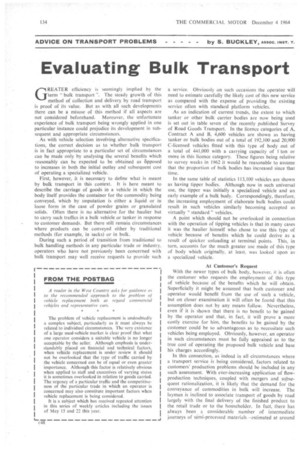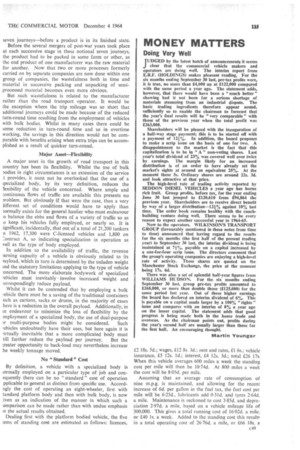Evaluating Bulk Transport
Page 136

Page 137

Page 138

If you've noticed an error in this article please click here to report it so we can fix it.
GREATER efficiency is seemingly implied by the term "bulk transport ". The steady growth of this method of collection and delivery, by road transport is proof of its value. But as with all such developments there can be a misuse of this method if all aspects are not considered beforehand. Moreover, the unfortunate experience of bulk transport being wrongly applied in one particular instance could prejudice its development in subsequent and appropriate circumstances.
As with vehicle selection involving alternative specifications, the correct decision as to whether bulk transport is in fact appropriate to a particular set of circumstances can be made only by analysing the several benefits which reasonably can be expected to be obtained as opposed to increases in both the initial outlay and subsequent cost of operating a specialized vehicle.
First, however, it is necessary to define what is meant by bulk transport in this context. it is here meant to describe the carriage of goods in a vehicle in which the body itself provides the container for the commodity being conveyed, which by imputation is either a liquid or in loose form in the case of powder grains or granulated solids. Often there is no alternative for the haulier but to carry such traffics in a bulk vehicle or tanker in response to customer demands. But there still remain circumstances where products can be conveyed either by traditional methods (for example, in sacks) orin bulk.
During such a period of transition from traditional to bulk handling methods in any particular trade or industry, operators who have not previously been concerned with bulk transport may well receive requests to provide such
a service. Obviously on such occasions the operator will need to estimate carefully the likely cost of this new service as compared with the expense of providing the existing service often with standard platform vehicles.
As an indication of current trends, the extent to which tanker or other bulk carrier bodies are now being used is set out in table seven of the recently published Survey of Road Goods Transport. In the licence categories of A, Contract A and B, 4,600 vehicles are shown as having tanker or bulk bodies out of a total of 192,100 and 20,900 C-licensed vehicles fitted with this type of body out of a total of 441,000 with a carrying capacity of 1 ton or more in this licence category. These figures being relative to survey weeks in 1962 it would be reasonable to assume that the proportion of bulk bodies has increased since that time.
In the same table of statistics 113,100 vehicles are shown as having tipper bodies. Although now in such universal use, the tipper was initially a specialized vehicle and an early example of a bulk body. Correspondingly, therefore, the increasing employment of elaborate bulk bodies could result in such vehicles similarly becoming accepted as virtually " standard " vehicles.
A point which should not be overlooked in connection with the operation of tipping vehicles is that in many cases it was the haulier himself who chose to use this type of vehicle because of benefits which he could derive as a result of quicker unloading at terminal points. This, in turn, accounts for the much greater use made of this type of body which originally, at feast, was looked upon as a specialized -vehicle.
At Customer's Request With the newer types of bulk body, however, it is often the customer who requests the employment of this type of vehicle because of the benefits which he will obtain. Superficially it might be assumed that both customer and operator would benefit from the use of such a vehicle, but on closer examination it will often be found that this assumption does not by any means follow. Nevertheless, even if it is shown that there is no benefit to be gained by the operator and that, in fact, it will prove a more costly exercise for him, the benefits to be gained by the customer could be so advantageous as to necessitate such vehicles being employed. Obviously, however, an operator in such circumstances must be fully appraised as to the true cost of operating the proposed bulk vehicle and base his charges accordingly.
In this connection, as indeed in all circumstances where a transport service is being considered, factors related to customers' production problems should he included in any such assessment. With e'er-increasing application of flowproduction techniques, coupled with mergers and subsequent rationalization, it is likely that the demand' for the conveyance of commodities in bulk will increase. The layman is inclined to associate transport of goods by road largely with the final delivery of the finished product to the retail trade or to the householder. In fact, there has always been a considerable number of intermediate journeys of semi-processed materials—estimated at around seven journeys—before a product is in its finished state.
Before the several mergers of post-war years took place at each successive stage in these notional seven journeys, the product had to be packed in some form or other, as the end product of one manufacturer was the raw material for another. Now that two or more processes formerly carried on by separate companies are now done within one group of companies, the wastefulness both in time and material in successive packing and unpacking of semiprocessed material becomes even more obvious.
But such wastefulness is related to the manufacturer rather than the road transport operator. It would be the exception where the trip mileage was so short that additional journeys could be made because of the reduced turn-round time resulting from the employment of vehicles with bulk bodies. Whilst in many cases there could be some reduction in turn-round time and so in overtime working, the savings in this direction would not be comparable with benefits arising when extra trips can be accomplished as a result of quicker turn-round.
Major Asset—Flexibility A major asset in the growth of road transport in this country has been its flexibility. Whilst the use of bulk 3odies in right circumstances is an extension of the service t provides, it must not be overlooked that the use of a ;pecialized body, by its very definition, reduces the iexibility of the vehicle concerned. Where ample and :ontinuous flows of traffic are available this presents no )roblem. But obviously if that were the case, then a very lifferent set of conditions would have to apply than formally exists for the general haulier who must endeavour
o balance the ebbs and flows of a variety of traffic so as o keep his vehicles fully employed, or nearly so. It is fignificant, incidentally, that out of a total of 21,200 tankers
n 1962, 17,300 were C-licensed vehicles and 1,800 on -2ontract A, so indicating specialization in operation as vell as the type of body employed.
In addition to the availability of traffic, the revenue farning capacity of a vehicle is obviously related to its )ayload, which in turn is determined by the unladen weight Ind the statutory limitations applying to the type of vehicle :oncerned. The more elaborate bodywork of specialized 'chides must inevitably involve increased weight and :orrespondingly reduce payload.
Whilst it can be contended that by employing a bulk Thiele there must be a saving of the traditional containers uch as cartons, sacks or drums, in the majority of cases here is a reduction in the overall payload. Additionally, in in endeavour to minimize the loss of flexibility by the fmployment of a specialized body, the use of dual-purpose n. multi-purpose bodies might be considered. Such Thicles undoubtedly have their uses, but here again it is rirtually inevitable that a more complicated body must till further reduce the payload per journey. But the treater opportunity to back-load may nevertheless increase he weekly tonnage moved, No " Standard " Cost By definition, a vehicle with a specialized body is iormally employed on a particular type of job and conequently there can be no " standard " cost of operation pplicable to general as distinct from specific use. Accordngly the cost of operating an eight-wheeler, first with tandard platform body and then with bulk body, is now iven as an indication of the manner in which such a omparison can be made rather than with undue emphasis n the actual results obtained.
Dealing first with the platform bodied vehicle, the five :ems of standing cost are estimated as follows: licences,
£2 183. 5d.; wages, £12 8s. 3d.; rent and rates, £1 6s.; vehicle insurance, £5 12s. id.; interest, £4 12s, 3d.; total £26 17s.
When this vehicle averages 600 miles a week the standing cost per mile will then be 10-74d. At 800 miles a week the cost will be 8.05d. per mile.
Assuming that an average rate of consumption of nine m.p.g. is maintained, and allowing for the recent increase of 6d. per gallon in the fuel tax, the fuel cost per mile will be 6.25d., lubricants add 0.31d. and tyres 2-64d. a mile. Maintenance is reckoned to cost 3.85d. and depreciation 2.97d. a mile, based on a vehicle mileage life of 300,000. This gives a total running cost of 16-02d. a mile, or £40 Is. a week. Added to the standing cost this results in a total operating cost of 26.76d. a mile, or £66 18s. a week, when 600 miles are, averaged, and 23.71d. a mile, or £79 Is. a week when 800 miles are averaged.
It was assumed that the platform bodied vehicle cost £4,615. It is now reckoned that the bulk vehicle costs £8,000 complete and that the unladen weight has been increased from 7 tons 10 cwt. for the platform vehicle to 9 tons 5 cwt. The corresponding standing costs per week are now:. licences, £3 15s. 3d.; wages, E12 8s. 3d.; rent and rates, £.1 6s.; insurance, £6 4s.; interest, £8; total £31 13s. 6d. With a reduction to 8 m.p.g., the fuel cost becomes 7-03d. a mile, whilst maintenance costs are increased to 4'S Id. and depreciation to 5-73d. per mile. The resulting total operating cost is 33.19d. a mite, or £82 19s. 6d. a week at 600 miles a week, and 29.66d. a mile, or £98 17s. 6d. a week when 800 miles are added.
Comparison of these arbitrary estimates emphasizes the even greater need for maximum utilization when specialized bodies involving increased outlay are employed. •
































































































































































































